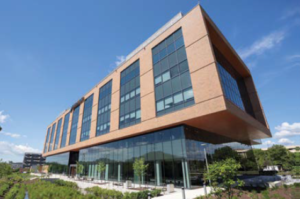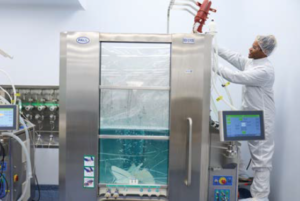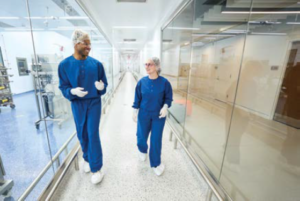Building Manufacturing Capabilities for Adenoassociated Virus Vectors: Key Considerations for Facility Design and OperationsBuilding Manufacturing Capabilities for Adenoassociated Virus Vectors: Key Considerations for Facility Design and Operations

The Regenxbio Manufacturing Innovation Center in Rockville, MD.
Demand for gene therapies based on adenoassociated virus (AAV) vectors continues to exceed manufacturing capacity. Part of the imbalance stems from the growing number of AAV-based candidates that are advancing through clinical studies. Zhao et al. report that, in September 2021, researchers were enrolling participants for and/or conducting 137 trials for such products (1). As of August 2022, three AAV-based therapies have received commercial authorization in the United States and/or European Union, and other products have received conditional approval (2–5). Without a doubt, the COVID-19 pandemic has exacerbated preexisting shortages by compelling biopharmaceutical companies to direct considerable labor, research, and manufacuring resources to developing SARS-CoV-2 vaccines and antivirals. Several contract development/manufacturing organizations (CDMOs/CMOs) have pledged to install new manufacturing capacity to address current shortages (6, 7). However, some gene therapy developers have decided to build manufacturing capabilities to help ensure capacity availability and increase control over operations (8–11).
Among those companies is Regenxbio. Early in 2019, the company announced plans to equip its 132,000-ft2 facility in Rockville, MD, with 20,000 ft2 of dedicated space for end-to-end, good manufacturing practice (GMP) production of its therapeutic programs (12). Those include AAV-mediated therapies for rare diseases such as Duchenne muscular dystrophy, Hunter syndrome, and Hurler syndrome. Named the Regenxbio Manufacturing Innovation Center, the site’s new manufacturing areas were designed to support the company’s NAVXpress AAV platform, which leverages suspension cell cultures to produce vectors in batches up to 2,000 L. The site came online for GMP operations in June 2022 (13).
To learn about the impetus behind establishing internal manufacturing capabilities, I spoke with Curran Simpson (chief operations and technology officer at Regenxbio). Recalling personal and team experiences, Simpson highlighted critical considerations for AAV facility design and operations.
Simpson has over 30 years of experience in the biotechnology sector, including time as head of North American supply chain and interim chief operating officer at GlaxoSmithKline (GSK). He also has served as senior vice president of operations at Human Genome Sciences (now part of GSK) and held directorships at Biogen, Diosynth Biotechnologies (Fujifilm), and NovoNordisk.

HTTPS://REGENXBIO.COM
Building Internal Manufacturing Capacity
Why did your company decide to establish internal AAV production capacity? We’ve outsourced manufacturing for around seven years through a couple of different contract partners. Our initial process used an adherent human embryonic kidney (HEK)293 cell line. With that, we couldn’t increase scales beyond 200 L because the process required considerable time and resources. Just in terms of handling, it is difficult to work with more than 50 or 60 adherent-culture vessels at any given time. Operators would spend 15 hours each day changing out media and performing related activities.
Before joining Regenxbio, most of my team members worked with companies that specialized in protein biologics, and together we had a good amount of experience with suspension cell culture. Thus, the first thing that we did was to adapt our cell lines to a suspension-based platform process. That work provided the basis for our company’s high-yielding NAVXpress AAV manufacturing platform. In 2019, Regenxbio announced plans to build a facility that would support the platform, and today we are performing GMP operations.
The decision to construct the facility turned out to be critically important. It was made before the onset of the COVID-19 pandemic, which has contributed to the “capacity crunch” that most gene therapy companies are experiencing now.
How difficult was it to construct the facility during the pandemic? We faced issues with obtaining materials of construction. Builders needed to be staggered across different shifts of fewer workers, but we did not lose significant time. The pandemic certainly influenced our facility build, but I believe that diligent planning enabled us to navigate through difficulties. I also attribute our success to having a seasoned team and minimizing changes along the building journey — which can be difficult. You learn things as you are building and as you watch the industry evolve. You might see things that make you want to introduce changes, but we had a solid plan.
How would you describe the facility design that your team implemented? One important design consideration was flexibility. We needed the facility to handle activities for clinical production but also be built for commercial manufacturing standards because we planned to produce validation lots in house and potentially to launch commercial products out of the facility. We pressure-tested our design concept with the US Food and Drug Administration (FDA) and received good feedback.
We started with a conservative design — for instance, with key facility areas receiving their own air-handling systems. We didn’t need to make many changes based on initial feedback or even when the design was visualized in three dimensions. We packed a considerable amount of manufacturing capacity into that design.
Our new headquarters, where the Regenxbio Manufacturing Innovation Center is located, also houses our offices and laboratories. A primary challenge was to install a manufacturing environment into such conditions. For instance, we needed to overcome problems with bioreactor fit. In some cases, our bioreactors were nearly as tall as the rooms in which they were housed. We designed headspace into such areas to help ensure fit.
Because we were able to incorporate manufacturing capabilities into that setting, our manufacturing group now is nested one floor above our process development group. Having those groups together has been a significant advantage for us. For instance, we were able to perform a small-scale simulation of a manufacturing-scale run in the development laboratory one floor below us, then compare results from those studies. This colocation of manufacturing and laboratory spaces allows us to accelerate the development of our AAV gene therapies.
Although our design was conservative, we also built the facility to be flexible. Not knowing what processes and technologies the gene therapy industry might be using in five to 10 years, we wanted to make sure that our facility would not limit new possibilities. Let’s assume that 70% of gene therapy manufacturers currently use triple-transfection methods, many of which leverage HEK293 cells. A different cell line could materialize in the next decade. That line could come to dominate the industry — much as Chinese hamster ovary (CHO) cells have become the primary system for antibody products. We designed our facility with the ability to handle alternative cell lines that we might not be using today.
For similar reasons, we incorporated viral segregation into the facility and room designs. Although we don’t introduce live virus at any point in our process today, we don’t want to preclude that possibility. For instance, baculovirus expression vector production requires live virus and therefore virus-positive and -negative compartmentalization.

HTTPS://REGENXBIO.COM
Comparing AAV and Protein Production Facilities
You noted your team’s experience with protein biologics. How much do requirements for, say, small-scale monoclonal antibody (MAb) manufacturing facilities align with those for production of AAV-based gene therapies? We have had success with incorporating insights from biologics manufacturing into gene therapy production. In the protein space, much of my team worked with batches of 5,000 L and even 20,000 L. They’re not daunted by scale-up to 2,000-L batches, which would represent seed vessels for MAb processes. I also estimate that 70% of the equipment that we selected for gene therapy production has origins in biologics manufacturing; we largely are using the same types of chromatography columns and bioreactors.
However, transfection processes are unique to gene therapy and are extremely difficult to scale up. One factor is that transfection mixes aren’t stable for as long as we might like them to be. Thus, there’s an urgency to deliver a mix once it is made, and that material represents a large-volume addition to a bioreactor. The process also becomes more difficult as you reach 2,000 L. The gene therapy industry is working to address these current limitations. Regenxbio is developing new methods based on technologies for in-line mixing and the like.
I remember that, for a while, MAb production was a “power game” — what’s the largest impeller that you could add to your bioreactor, and what is the maximum level of power and shear that your host cells can endure? The goal was to maximize cell density and, thereby, protein expression. Gene therapy is different from that. Transfection processes must be gentle. High shear is a disaster for yield, so we prevent it as much as possible. Moving to transfection processes required a huge change in mindset for those of us who had worked with high cell densities in high-shear systems. We needed to throw out some preconceived notions and consider new methods designed specifically to increase vector expression. I’m proud that our NAVXpress platform has demonstrated robust scalability with consistent yield and product purity during comparability studies.
As with protein biologics, depth filters and related equipment are used for upfront separation of vectors from transfection and culture components. For AAV vectors, you’re probably close to the limit of a good depth-filtration process at 2,000 L. To move beyond that plateau, scientists are starting to use centrifuges. That’s an area to watch.
Downstream requirements for protein and AAV purification have many similarities. Scientists largely have moved away from ultracentrifugation toward column chromatography. Several effective affinity resins for vector capture are commercially available.
A key consideration for manufacturing gene therapies is that bulk sizes can come in the order of liters rather than tens of liters. Thus, minimizing volumetric holdup is a critical factor for maximizing yield. You want to ensure that your systems will capture as much material as possible at the end of downstream processing.
Operational Considerations
How does your facility’s design account for flows of materials and personnel? When you design a facility, you keep a certain number of annual batches in mind. Often, the tendency is to exceed that output once you get into late-clinical and commercial production. That’s how you get into trouble with flows of raw materials. As long as you stay within your design criteria, you should be in good shape for flows of materials through your facility.
Regenxbio uses large remote warehouses to support our onsite warehouse. We’re spartan about space use on the first floor, which is where we perform weighing, dispensing, and staging. A dedicated elevator takes staged materials upstairs. We designed common buffer and media preparation areas to distribute materials uniformly to both of our production trains. We also have instituted a platform process that is virtually identical across our programs. Thus, 95% of the raw materials used for product A are the same ones used to manufacture product B.
Because of such a setup, we don’t have duplication of resources. That saves us a lot in terms of costs and facility requirements. Storing one raw material that can be used on four programs is highly efficient, and our platform process enables us to perform multiproduct manufacturing in a fairly small footprint.
How integral were single-use and automation technologies to your facility design? Our facility would not be operational yet if we didn’t select single-use systems. Biologics manufacturing plants that were built with reusable/stainless-steel systems all needed to go through extensive clean-/steam-in-place (CIP/SIP) cycles that required validation. That process can take 18 months. When you select single use, you significantly reduce the time needed for facility construction and validation processes.
Like many other biopharmaceutical companies, we have room to improve regarding automation capabilities. All of our equipment is tied into a central platform. We can watch remotely just about every unit operation in our facility. We also have brought in a digital inventory system designed by Oracle. Incorporating that level of automation was a purposeful decision. Automated systems help to ensure compliance in terms of data management and integrity. They also help you to capture electronically as much data as you can from each run.
Automation implementation was among the most difficult activities associated with bringing our facility online, but it was worth doing. We now can have scientists monitor bioreactor performance remotely from home, perhaps with a small team on site. We also can share data seamlessly with our process development and quality teams. I believe that we’ve struck a good balance at the onset of our operations: Now, we will use electronic records for tasks such as solution preparation, but in the long term, the desire is to have all electronic batch records, as well.
What considerations often are left out of discussions about AAV manufacturing? One “untold story” is that developers often have difficulty finding fill–finish capacity for gene therapy products. In 2023, our facility will be implementing isolator technology for a fill line. Then, we will have both bulk drug manufacturing and fill–finish capabilities in house.
I was skeptical about that strategy when we were designing the facility because so many fill–finish areas are tailored to particular products. Vial configurations can differ across technologies. Fill lines based on new isolator technologies can handle anything from a 2-mL to a 20-mL vial. But during line validation, fill sites might not include some of those vial sizes — e.g., the small vial size that we use for ocular products. Developers might also struggle to find a contract fill line that fits their programs’ needs. Some programs might require filling of 10,000 vials, whereas for rare disease indications such as the ones that we work with at Regenxbio, you might need to fill only a hundred 10-mL vials.
Ultimately, the decision to establish our own fill line will be a significant advantage. That way, we won’t need to fight day to day to find capacity.
References
1 Zhao Z, Anselmo AC, Mitragotri S. Viral Vector-Based Gene Therapies in the Clinic. Bioeng. Transl. Med. 7(1) 2021: e10258; https://doi.org/10.1002/btm2.10258.
2 Approved Cellular and Gene Therapy Products. US Food and Drug Administration, accessed 17 August 2022; https://www.fda.gov/vaccines-blood-biologics/cellular-gene-therapy-products/approved-cellular-and-gene-therapy-products.
3 Advanced Therapy Medicinal Products. European Medicines Agency, accessed 17 August 2022; https://www.ema.europa.eu/en/human-regulatory/overview/advanced-therapy-medicinal-products-overview.
4 First Gene Therapy to Treat Severe Haemophilia A (press release). European Medicines Agency, 24 June 2022; https://www.ema.europa.eu/en/news/first-gene-therapy-treat-severe-haemophilia.
5 Gardner J. PTC’s First Gene Therapy Gains European Regulator’s Backing. Biopharma Dive 20 May 2022; https://www.biopharmadive.com/news/ptc-gene-therapy-ema-europe-aadc-deficiency/624138.
6 Nelson M. Lack of AAV Capacity Drives $120 Million Investment for Forge Biologics. BioProcess Insider 4 May 2021; https://bioprocessintl.com/bioprocess-insider/lack-of-aav-capacity-drives-120m-investment-for-forge-biologics.
7 Nelson M. Batavia Ups Capacity at Netherlands Plant. BioProcess Insider 20 June 2022; https://bioprocessintl.com/bioprocess-insider/facilities-capacity/batavia-ups-capacity-at-netherlands-plant.
8 Nelson M. Neuropath Gene Therapy Plant a Nod to China’s Preference for In-House. BioProcess Insider 30 September 2021; https://bioprocessintl.com/bioprocess-insider/facilities-capacity/neurophth-gene-therapy-plant-a-nod-to-chinas-preference-for-inhouse.
9 Stanton D. Allogene and Regenxbio Point to In-House CGT Advantage. BioProcess Insider 10 May 2021; https://bioprocessintl.com/bioprocess-insider/facilities-capacity/allogene-and-regenxbio-point-to-inhouse-cgt-advantage.
10 Stanton D. Tenaya Talks Advantages of In-House Capabilities for CGT Firms. BioProcess Insider 19 April 2021; https://bioprocessintl.com/bioprocess-insider/facilities-capacity/tenaya-talks-advantages-of-inhouse-capabilities-for-cgt-firms.
11 Nelson M. Adverum: “Scarcity of AAV Capacity Drove Inhouse Investment.” BioProcess Insider 15 January 2021; https://bioprocessintl.com/bioprocess-insider/adverum-scarcity-of-aav-capacity-drove-inhouse-investment.
12 Stanton D. Regenxbio Building Maryland AAV Plant to Support Gene Therapies. BioProcess Insider 22 May 2019; https://bioprocessintl.com/bioprocess-insider/facilities-capacity/regenxbio-building-maryland-aav-plant-to-support-gene-therapies.
13 Nelson M. Regenxbio Opens Maryland Plant. BioProcess Insider 16 June 2022; https://bioprocessintl.com/bioprocess-insider/facilities-capacity/regenxbio-opens-maryland-aav-plant.
Brian Gazaille is managing editor of BioProcess International, part of Informa Connect Life Sciences; [email protected].
You May Also Like





